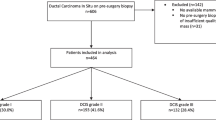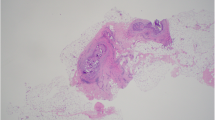Abstract
Purpose of Review
We aim to review the appearance of ductal carcinoma in situ (DCIS) across the spectrum of imaging modalities used in common clinical practice.
Recent Findings
Changes in technology and clinical breast cancer screening patterns have impacted the imaging evaluation of DCIS. DCIS classically presents as asymptomatic calcifications in women undergoing screening mammography. The replacement of traditional 2D mammography with digital breast tomosynthesis has changed the typical appearance of screen-detected DCIS. Ultrasound is traditionally utilized to detect DCIS in women with clinical symptoms, but efforts to increase screening ultrasound rates for women with dense breasts makes it more important to identify the appearance of DCIS in asymptomatic women. Improvements in MRI technology have made MRI the most sensitive imaging modality to detect DCIS and define the extent of disease, which is increasingly important given greater utilization of MRI for high-risk screening and determination of extent of known disease. Finally, the emergence of active surveillance, or non-surgical management, for DCIS has increased the focus on presurgical identification of associated invasive cancer, with early results demonstrating promise via computer vision and deep learning approaches for this task.
Summary
DCIS has a highly variable imaging appearance which is subject to changes in imaging technology and clinical management.









Similar content being viewed by others
References
Papers of particular interest, published recently, have been highlighted as: • Of importance •• Of major importance
American Joint Committee on Cancer. Breast Cancer Staging 7th edition. In: American Cancer Society.
Cancer facts & figures 2017. In: American Cancer Society,
Hooley RJ. Breast density legislation and clinical evidence. Radiol Clin N Am. 2017;55:513–26. https://doi.org/10.1016/j.rcl.2016.12.006.
Monticciolo DL, Newell MS, Moy L, Niell B, Monsees B, Sickles EA. Breast cancer screening in women at higher-than-average risk: recommendations from the ACR. J Am Coll Radiol. 2018;15:408–14. https://doi.org/10.1016/j.jacr.2017.11.034.
Yamada T, Mori N, Watanabe M, et al. Radiologic-pathologic correlation of ductal carcinoma in situ. Radiographics. 2010;30:1183–98. https://doi.org/10.1148/rg.305095073.
Barreau B, de Mascarel I, Feuga C, et al. Mammography of ductal carcinoma in situ of the breast: review of 909 cases with radiographic-pathologic correlations. Eur J Radiol. 2005;54:55–61. https://doi.org/10.1016/j.ejrad.2004.11.019.
O'Grady S, Morgan MP. Microcalcifications in breast cancer: from pathophysiology to diagnosis and prognosis. Biochim Biophys Acta Rev Cancer. 1869;2018:310–20. https://doi.org/10.1016/j.bbcan.2018.04.006.
Cox RF, Morgan MP. Microcalcifications in breast cancer: lessons from physiological mineralization. Bone. 2013;53:437–50. https://doi.org/10.1016/j.bone.2013.01.013.
• D’Orsi CJSE, Mendelson EB, Morris EA. ACR BI-RADS® Atlas, Breast Imaging Reporting and Data System. Reston: American College of Radiology; 2013. Primary lexicon by which breast radiologists interpret breast imaging studies.
Rauch GM, Hobbs BP, Kuerer HM, et al. Microcalcifications in 1657 patients with pure ductal carcinoma in situ of the breast: correlation with clinical, histopathologic, biologic features, and local recurrence. Ann Surg Oncol. 2016;23:482–9. https://doi.org/10.1245/s10434-015-4876-6.
Lee AY, Wisner DJ, Aminololama-Shakeri S, et al. Inter-reader variability in the use of BI-RADS descriptors for suspicious findings on diagnostic mammography: a multi-institution study of 10 academic radiologists. Acad Radiol. 2017;24:60–6. https://doi.org/10.1016/j.acra.2016.09.010.
Holmberg L, Wong YN, Tabar L, et al. Mammography casting-type calcification and risk of local recurrence in DCIS: analyses from a randomised study. Br J Cancer. 2013;108:812–9. https://doi.org/10.1038/bjc.2013.26.
Malik HZ, Wilkinson L, George WD, Purushotham AD. Preoperative mammographic features predict clinicopathological risk factors for the development of local recurrence in breast cancer. Breast. 2000;9:329–33. https://doi.org/10.1054/brst.1999.0148.
Stomper PC, Connolly JL. Ductal carcinoma in situ of the breast: correlation between mammographic calcification and tumor subtype. AJR Am J Roentgenol. 1992;159:483–5. https://doi.org/10.2214/ajr.159.3.1323923.
Evans A, Pinder S, Wilson R, et al. Ductal carcinoma in situ of the breast: correlation between mammographic and pathologic findings. AJR Am J Roentgenol. 1994;162:1307–11. https://doi.org/10.2214/ajr.162.6.8191988.
Dinkel HP, Gassel AM, Tschammler A. Is the appearance of microcalcifications on mammography useful in predicting histological grade of malignancy in ductal cancer in situ? Br J Radiol. 2000;73:938–44. https://doi.org/10.1259/bjr.73.873.11064645.
Slanetz PJ, Giardino AA, Oyama T, et al. Mammographic appearance of ductal carcinoma in situ does not reliably predict histologic subtype. Breast J. 2001;7:417–21.
Leonard GD, Swain SM. Ductal carcinoma in situ, complexities and challenges. J Natl Cancer Inst. 2004;96:906–20.
Stomper PC, Connolly JL, Meyer JE, Harris JR. Clinically occult ductal carcinoma in situ detected with mammography: analysis of 100 cases with radiologic-pathologic correlation. Radiology. 1989;172:235–41. https://doi.org/10.1148/radiology.172.1.2544922.
Yang WT, Tse GM. Sonographic, mammographic, and histopathologic correlation of symptomatic ductal carcinoma in situ. AJR Am J Roentgenol. 2004;182:101–10. https://doi.org/10.2214/ajr.182.1.1820101.
•• Brennan ME, Turner RM, Ciatto S, et al. Ductal carcinoma in situ at core-needle biopsy: meta-analysis of underestimation and predictors of invasive breast cancer. Radiology. 2011;260:119–28. https://doi.org/10.1148/radiol.11102368A large meta-analysis demonstrating upstaging rates for DCIS to invasive disease and presurgical factors associated with upstaging.
Hermann G, Janus C, Schwartz IS, Papatestas A, Hermann DG, Rabinowitz JG. Occult malignant breast lesions in 114 patients: relationship to age and the presence of microcalcifications. Radiology. 1988;169:321–4. https://doi.org/10.1148/radiology.169.2.2845470.
Sekine K, Tsunoda-Shimizu H, Kikuchi M, Saida Y, Kawasaki T, Suzuki K. DCIS showing architectural distortion on the screening mammogram—comparison of mammographic and pathological findings. Breast Cancer. 2007;14:281–4.
Su X, Lin Q, Cui C, et al. Non-calcified ductal carcinoma in situ of the breast: comparison of diagnostic accuracy of digital breast tomosynthesis, digital mammography, and ultrasonography. Breast Cancer. 2017;24:562–70. https://doi.org/10.1007/s12282-016-0739-7.
Xu Y, Miyake KK, Liu YI, et al. The Milky Way Sign: a new diagnostic finding of ductal carcinoma in situ on digital breast tomosynthesis. Breast J. 2016;22:349–51. https://doi.org/10.1111/tbj.12583.
Bernardi D, Macaskill P, Pellegrini M, et al. Breast cancer screening with tomosynthesis (3D mammography) with acquired or synthetic 2D mammography compared with 2D mammography alone (STORM-2): a population-based prospective study. Lancet Oncol. 2016;17:1105–13. https://doi.org/10.1016/S1470-2045(16)30101-2.
Caumo F, Zorzi M, Brunelli S, et al. Digital breast tomosynthesis with synthesized two-dimensional images versus full-field digital mammography for population screening: outcomes from the Verona screening program. Radiology. 2018;287:37–46. https://doi.org/10.1148/radiol.2017170745.
Kopans DB. Digital breast tomosynthesis from concept to clinical care. AJR Am J Roentgenol. 2014;202:299–308. https://doi.org/10.2214/AJR.13.11520.
•• Horvat JV, Keating DM, Rodrigues-Duarte H, Morris EA, Mango VL. Calcifications at digital breast tomosynthesis: imaging features and biopsy techniques. Radiographics. 2019;39:307–18. https://doi.org/10.1148/rg.2019180124A review of the appearance of calcifications on digital breast tomosynthesis.
Hwang E, Szabo J, Sonnenblick EB, Margolies LR. Variable appearances of ductal carcinoma in situ calcifications on digital mammography, synthesized mammography, and tomosynthesis: a pictorial essay. Can Assoc Radiol J. 2018;69:2–9. https://doi.org/10.1016/j.carj.2017.04.005.
Berger N, Schwizer SD, Varga Z, Rageth C, Frauenfelder T, Boss A. Assessment of the extent of microcalcifications to predict the size of a ductal carcinoma in situ: comparison between tomosynthesis and conventional mammography. Clin Imaging. 2016;40:1269–73. https://doi.org/10.1016/j.clinimag.2016.09.003.
Bernardi D, Caumo F, Macaskill P, et al. Effect of integrating 3D-mammography (digital breast tomosynthesis) with 2D-mammography on radiologists’ true-positive and false-positive detection in a population breast screening trial. Eur J Cancer. 2014;50:1232–8. https://doi.org/10.1016/j.ejca.2014.02.004.
Tagliafico A, Mariscotti G, Durando M, et al. Characterisation of microcalcification clusters on 2D digital mammography (FFDM) and digital breast tomosynthesis (DBT): does DBT underestimate microcalcification clusters? Results of a multicentre study. Eur Radiol. 2015;25:9–14. https://doi.org/10.1007/s00330-014-3402-8.
Ikeda DM, Andersson I. Ductal carcinoma in situ: atypical mammographic appearances. Radiology. 1989;172:661–6. https://doi.org/10.1148/radiology.172.3.2549563.
•• Horvat JV, Keating DM, Rodrigues-Duarte H, Morris Wang LC, Sullivan M, Du H, et al. US appearance of ductal carcinoma in situ. Radiographics. 2013;33:213–28. https://doi.org/10.1148/rg.331125092A review of the appearance of DCIS on ultrasound.
Watanabe T, Yamaguchi T, Tsunoda H, et al. Ultrasound image classification of ductal carcinoma in situ (DCIS) of the breast: analysis of 705 DCIS lesions. Ultrasound Med Biol. 2017;43:918–25. https://doi.org/10.1016/j.ultrasmedbio.2017.01.008.
• Mesurolle B, El-Khoury M, Khetani K, Abdullah N, Joseph L, Kao E. Mammographically non-calcified ductal carcinoma in situ: sonographic features with pathological correlation in 35 patients. Clin Radiol. 2009;64:628–36. https://doi.org/10.1016/j.crad.2008.12.013Unique ultrasound presentation of DCIS.
Moon HJ, Kim EK, Kim MJ, Yoon JH, Park VY. Comparison of clinical and pathologic characteristics of ductal carcinoma in situ detected on mammography versus ultrasound only in asymptomatic patients. Ultrasound Med Biol. 2019;45:68–77. https://doi.org/10.1016/j.ultrasmedbio.2018.09.003.
Moon WK, Im JG, Koh YH, Noh DY, Park IA. US of mammographically detected clustered microcalcifications. Radiology. 2000;217:849–54. https://doi.org/10.1148/radiology.217.3.r00nv27849.
Yu PC, Lee YW, Chou FF, et al. Clustered microcalcifications of intermediate concern detected on digital mammography: ultrasound assessment. Breast. 2011;20:495–500. https://doi.org/10.1016/j.breast.2011.05.003.
Moon WK, Myung JS, Lee YJ, Park IA, Noh DY, Im JG. US of ductal carcinoma in situ. Radiographics. 2002;22:269–80; discussion 280-261. https://doi.org/10.1148/radiographics.22.2.g02mr16269.
Soo MS, Baker JA, Rosen EL. Sonographic detection and sonographically guided biopsy of breast microcalcifications. AJR Am J Roentgenol. 2003;180:941–8. https://doi.org/10.2214/ajr.180.4.1800941.
•• Kuhl CK, Schrading S, Bieling HB, et al. MRI for diagnosis of pure ductal carcinoma in situ: a prospective observational study. Lancet. 2007;370:485–92. https://doi.org/10.1016/S0140-6736(07)61232-XDemonstrates the excellent sensitivity of MRI for the detection of DCIS, using modern MRI equipment.
Lehman CD, Gatsonis C, Kuhl CK, et al. MRI evaluation of the contralateral breast in women with recently diagnosed breast cancer. N Engl J Med. 2007;356:1295–303. https://doi.org/10.1056/NEJMoa065447.
Berg WA, Gutierrez L, NessAiver MS, et al. Diagnostic accuracy of mammography, clinical examination, US, and MR imaging in preoperative assessment of breast cancer. Radiology. 2004;233:830–49. https://doi.org/10.1148/radiol.2333031484.
Marcotte-Bloch C, Balu-Maestro C, Chamorey E, et al. MRI for the size assessment of pure ductal carcinoma in situ (DCIS): a prospective study of 33 patients. Eur J Radiol. 2011;77:462–7. https://doi.org/10.1016/j.ejrad.2009.09.003.
Proulx F, Correa JA, Ferre R, et al. Value of pre-operative breast MRI for the size assessment of ductal carcinoma in situ. Br J Radiol. 2016;89:20150543. https://doi.org/10.1259/bjr.20150543.
• Pickles MD, Gibbs P, Hubbard A, Rahman A, Wieczorek J, Turnbull LW. Comparison of 3.0 T magnetic resonance imaging and X-ray mammography in the measurement of ductal carcinoma in situ: a comparison with histopathology. Eur J Radiol. 2015;84:603–10. https://doi.org/10.1016/j.ejrad.2014.12.016Improved estimates of the extent of disease using 3T MRI systems compared to mammography.
Rahbar H, DeMartini WB, Lee AY, Partridge SC, Peacock S, Lehman CD. Accuracy of 3 T versus 1.5 T breast MRI for pre-operative assessment of extent of disease in newly diagnosed DCIS. Eur J Radiol. 2015;84:611–6. https://doi.org/10.1016/j.ejrad.2014.12.029.
Jansen SA, Newstead GM, Abe H, Shimauchi A, Schmidt RA, Karczmar GS. Pure ductal carcinoma in situ: kinetic and morphologic MR characteristics compared with mammographic appearance and nuclear grade. Radiology. 2007;245:684–91. https://doi.org/10.1148/radiol.2453062061.
Menell JH, Morris EA, Dershaw DD, Abramson AF, Brogi E, Liberman L. Determination of the presence and extent of pure ductal carcinoma in situ by mammography and magnetic resonance imaging. Breast J. 2005;11:382–90. https://doi.org/10.1111/j.1075-122X.2005.00121.x.
Rosen EL, Smith-Foley SA, DeMartini WB, Eby PR, Peacock S, Lehman CD. BI-RADS MRI enhancement characteristics of ductal carcinoma in situ. Breast J. 2007;13:545–50. https://doi.org/10.1111/j.1524-4741.2007.00513.x.
Buadu LD, Murakami J, Murayama S, et al. Breast lesions: correlation of contrast medium enhancement patterns on MR images with histopathologic findings and tumor angiogenesis. Radiology. 1996;200:639–49. https://doi.org/10.1148/radiology.200.3.8756909.
Jansen SA, Paunesku T, Fan X, et al. Ductal carcinoma in situ: X-ray fluorescence microscopy and dynamic contrast-enhanced MR imaging reveals gadolinium uptake within neoplastic mammary ducts in a murine model. Radiology. 2009;253:399–406. https://doi.org/10.1148/radiol.2533082026.
D’Orsi CJSE, Mendelson EB, Morris EA, et al. ACR BI-RADS® atlas, breast imaging reporting and data system. Reston: American College of Radiology; 2013.
Tozaki M, Igarashi T, Fukuda K. Breast MRI using the VIBE sequence: clustered ring enhancement in the differential diagnosis of lesions showing non-masslike enhancement. AJR Am J Roentgenol. 2006;187:313–21. https://doi.org/10.2214/ajr.05.0881.
Esserman LJ, Kumar AS, Herrera AF, et al. Magnetic resonance imaging captures the biology of ductal carcinoma in situ. J Clin Oncol. 2006;24:4603–10. https://doi.org/10.1200/JCO.2005.04.5518.
Baur A, Bahrs SD, Speck S, et al. Breast MRI of pure ductal carcinoma in situ: sensitivity of diagnosis and influence of lesion characteristics. Eur J Radiol. 2013;82:1731–7. https://doi.org/10.1016/j.ejrad.2013.05.002.
Liu H, Peng W. MRI morphological classification of ductal carcinoma in situ (DCIS) correlating with different biological behavior. Eur J Radiol. 2012;81:214–7. https://doi.org/10.1016/j.ejrad.2010.12.084.
Fancellu A, Turner RM, Dixon JM, Pinna A, Cottu P, Houssami N. Meta-analysis of the effect of preoperative breast MRI on the surgical management of ductal carcinoma in situ. Br J Surg. 2015;102:883–93. https://doi.org/10.1002/bjs.9797.
• Lehman CD, Gatsonis C, Romanoff J, et al. Association of magnetic resonance imaging and a 12-gene expression assay with breast ductal carcinoma in situ treatment. JAMA Oncol. 2019. https://doi.org/10.1001/jamaoncol.2018.6269A prospective multi-center trial demonstrating that MRI alone accounts for a minority of conversion to mastectomy.
Luo J, Hippe DS, Rahbar H, Parsian S, Rendi MH, Partridge SC. Diffusion tensor imaging for characterizing tumor microstructure and improving diagnostic performance on breast MRI: a prospective observational study. Breast Cancer Res. 2019;21:102. https://doi.org/10.1186/s13058-019-1183-3.
Balleyguier C, Dunant A, Ceugnart L, et al. Preoperative breast magnetic resonance imaging in women with local ductal carcinoma in situ to optimize surgical outcomes: results from the randomized phase III trial IRCIS. J Clin Oncol. 2019;37:885–92. https://doi.org/10.1200/JCO.18.00595.
Esserman L, Yau C. Rethinking the standard for ductal carcinoma in situ treatment. JAMA Oncol. 2015;1:881–3. https://doi.org/10.1001/jamaoncol.2015.2607.
Chou SS, Gombos EC, Chikarmane SA, Giess CS, Jayender J. Computer-aided heterogeneity analysis in breast MR imaging assessment of ductal carcinoma in situ: correlating histologic grade and receptor status. J Magn Reson Imaging. 2017;46:1748–59. https://doi.org/10.1002/jmri.25712.
Luo J, Johnston BS, Kitsch AE, et al. Ductal carcinoma in situ: quantitative preoperative breast MR imaging features associated with recurrence after treatment. Radiology. 2017;285:788–97. https://doi.org/10.1148/radiol.2017170587.
Grimm LJ, Hwang ES. Active surveillance for DCIS: the importance of selection criteria and monitoring. Ann Surg Oncol. 2016;23:4134–6. https://doi.org/10.1245/s10434-016-5596-2.
Kuerer HM. Ductal carcinoma in situ: treatment or active surveillance? Expert Rev Anticancer Ther. 2015;15:777–85. https://doi.org/10.1586/14737140.2015.1043897.
Comparison of operative versus medical endocrine therapy for LOw Risk DCIS: the COMET Trial. In: Patient-Centered Outcomes Research Institute.
LORIS A phase III trial of surgery versus active monitoring for low risk ductal carcinoma in situ (DCIS). In: University of Birmingham.
Management of LOw-Risk DCIS (LORD). In: The Netherlands Cancer Institute.
Grimm LJ, Ryser MD, Partridge AH, et al. Surgical upstaging rates for vacuum assisted biopsy proven DCIS: implications for active surveillance trials. Ann Surg Oncol. 2017;24:3534–40. https://doi.org/10.1245/s10434-017-6018-9.
Soumian S, Verghese ET, Booth M, et al. Concordance between vacuum assisted biopsy and postoperative histology: implications for the proposed LOw Risk DCIS Trial (LORIS). Eur J Surg Oncol. 2013;39:1337–40. https://doi.org/10.1016/j.ejso.2013.09.028.
Aminololama-Shakeri S, Flowers CI, McLaren CE, et al. Can radiologists predict the presence of ductal carcinoma in situ and invasive breast cancer? AJR Am J Roentgenol. 2017;208:933–9. https://doi.org/10.2214/AJR.16.16073.
•• Shi B, Grimm LJ, Mazurowski MA, et al. Can occult invasive disease in ductal carcinoma in situ be predicted using computer-extracted mammographic features? Acad Radiol. 2017;24:1139–47. https://doi.org/10.1016/j.acra.2017.03.013The first study to apply deep learning techniques to the task of predicting upstaging of DCIS to invasive cancer.
Hwang E, Duong S, Bedrosian I, et al. Abstract GS5-05: primary endocrine therapy for ER-positive ductal carcinoma in situ (DCIS) CALGB 40903 (Alliance). Cancer Research. 2018;78:GS5-05-GS05-05. https://doi.org/10.1158/1538-7445.Sabcs17-gs5-05.
Shi B, Grimm LJ, Mazurowski MA, et al. Prediction of occult invasive disease in ductal carcinoma in situ using deep learning features. J Am Coll Radiol. 2018;15:527–34. https://doi.org/10.1016/j.jacr.2017.11.036.
Harowicz MR, Saha A, Grimm LJ, et al. Can algorithmically assessed MRI features predict which patients with a preoperative diagnosis of ductal carcinoma in situ are upstaged to invasive breast cancer? J Magn Reson Imaging. 2017;46:1332–40. https://doi.org/10.1002/jmri.25655.
Funding
R01CA203883 (Rahbar)
Author information
Authors and Affiliations
Corresponding author
Ethics declarations
Conflict of Interest
Habib Rahbar reports grants from National Cancer Institute during the conduct of the study. Lars Grimm reports grants from Alliance Foundation Trial outside the submitted work. Nancy Ballantyne and Yun An Chen declare no conflicts of interest relevant to this manuscript.
Human and Animal Rights and Informed Consent
This article does not contain any studies with human or animal subjects performed by any of the authors.
Disclaimer
The funders had no role in the manuscript design, data analysis, decision to publish, or preparation of the manuscript.
Additional information
Publisher’s Note
Springer Nature remains neutral with regard to jurisdictional claims in published maps and institutional affiliations.
Nancy Ballantyne and Yun An Chen are co-first authors.
This article is part of the Topical Collection on Non-Invasive Breast Cancer Diagnosis and Treatment
Rights and permissions
About this article
Cite this article
Ballantyne, N., Chen, Y.A., Rabhar, H. et al. Multimodality Imaging of Ductal Carcinoma In Situ. Curr Breast Cancer Rep 12, 26–35 (2020). https://doi.org/10.1007/s12609-019-00349-9
Published:
Issue Date:
DOI: https://doi.org/10.1007/s12609-019-00349-9




